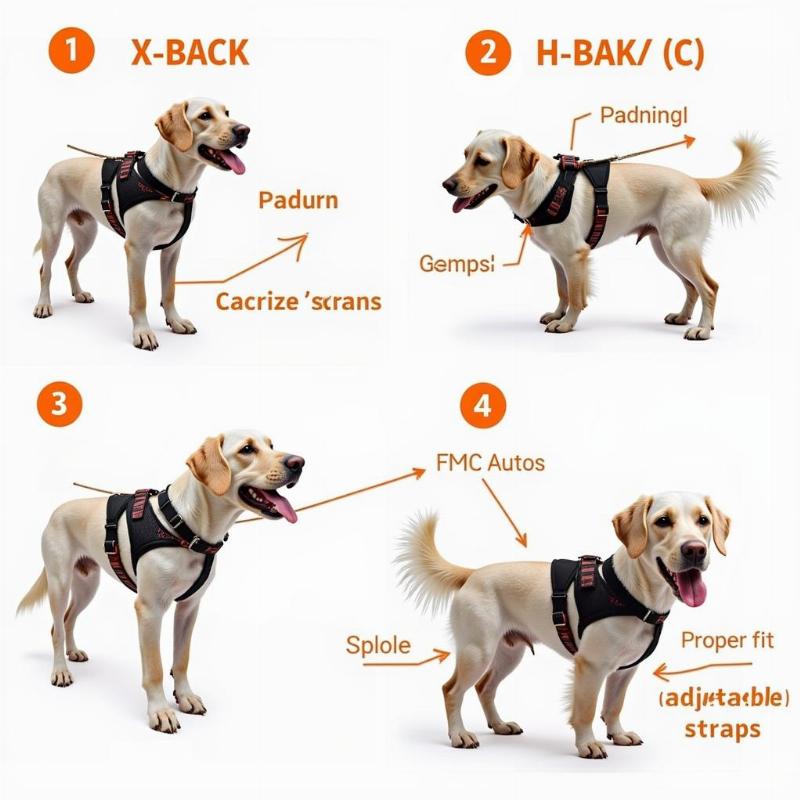A dog pulling harness and cart can be a fantastic way to enjoy the outdoors with your canine companion, providing both physical and mental stimulation. Whether you’re looking for a new adventure, a way to include your dog in errands, or an alternative form of exercise, understanding the nuances of dog pulling and carting is essential for a safe and enjoyable experience. This guide will explore everything you need to know about dog pulling harnesses and carts, from choosing the right equipment to training your dog and ensuring their safety and well-being.
Choosing the Right Dog Pulling Harness
Selecting the appropriate harness is crucial for your dog’s comfort and efficiency while pulling. Unlike a regular walking harness, a pulling harness is designed to distribute weight evenly across your dog’s chest and shoulders, minimizing strain and preventing injury.
- Proper Fit: The harness should fit snugly but not restrict movement. Ensure it allows for full range of motion in the legs and shoulders. A poorly fitting harness can cause chafing, discomfort, and even breathing difficulties.
- Material: Look for durable, breathable materials like nylon or padded webbing. Leather harnesses offer a classic look but require more maintenance.
- Type: There are two main types: the X-back harness and the H-back harness. X-back harnesses are generally preferred for pulling carts due to their even weight distribution. H-back harnesses can be suitable for lighter loads or dogs with shorter backs.
 Choosing the right dog pulling harness for your dog
Choosing the right dog pulling harness for your dog
Selecting the Right Cart for Your Dog
The cart you choose should be appropriate for your dog’s size, strength, and the terrain you’ll be traversing.
- Size and Weight Capacity: The cart should be proportionate to your dog’s size. Overloading the cart can strain your dog and cause injury. Always adhere to the manufacturer’s weight recommendations.
- Wheel Size and Terrain: Larger wheels are better suited for rough terrain, while smaller wheels are suitable for paved surfaces. Consider the type of terrain you’ll be using the cart on most frequently.
- Material and Construction: Look for a sturdy, well-built cart made from durable materials. Ensure the cart has good balance and stability to prevent tipping.
Training Your Dog for Carting
Introducing your dog to carting should be a gradual and positive experience.
- Start Slow: Begin by introducing the harness and cart separately. Let your dog get accustomed to wearing the harness and then gradually introduce the cart, initially without any weight.
- Positive Reinforcement: Use positive reinforcement methods such as treats and praise to encourage your dog. Keep training sessions short and fun.
- Voice Commands: Teach your dog basic commands like “pull,” “stop,” and “turn.” Consistency and patience are key.
- Gradual Weight Increase: Once your dog is comfortable pulling the empty cart, gradually increase the weight, always staying within their capacity.
Safety and Well-being
Your dog’s safety and well-being are paramount when carting.
- Weather Conditions: Avoid carting in extreme heat or cold. Provide plenty of water breaks and monitor your dog for signs of overheating or exhaustion.
- Terrain: Choose safe, even terrain free of obstacles. Avoid steep hills and rocky surfaces.
- Regular Breaks: Provide frequent breaks during carting sessions, especially for longer outings. Allow your dog to rest and recover.
- Veterinary Checkups: Regular veterinary checkups are essential to ensure your dog remains healthy and fit for pulling.
Conclusion
Dog pulling and carting can be a rewarding activity for both you and your dog. By choosing the right equipment, training your dog properly, and prioritizing their safety and well-being, you can create a fun and enriching experience for years to come. Remember to always consult with your veterinarian before starting any new exercise program with your dog.
FAQ
- What breeds are best suited for carting? Many breeds can enjoy carting, but larger, stronger breeds like Bernese Mountain Dogs, Newfoundlands, and Saint Bernards are often well-suited for the activity.
- How much weight can my dog pull? The amount of weight a dog can safely pull depends on their size, breed, and fitness level. Consult with your veterinarian for guidance.
- What age can a dog start carting? It’s best to wait until a dog’s bones and joints are fully developed, typically around 1-2 years old, before introducing carting.
- Is carting cruel? Carting is not inherently cruel, but it can be if done improperly. Prioritizing your dog’s comfort, safety, and well-being is crucial.
- What are the benefits of carting for dogs? Carting provides physical exercise, mental stimulation, and a sense of purpose for dogs. It can also be a great way to bond with your canine companion.
Beautdogs.us is your premier online destination for comprehensive and engaging information on dog care and companionship in the US. We offer expert advice on dog breeds, grooming, training, and health, catering to both new and experienced dog owners. Our commitment to providing reliable information and promoting responsible pet ownership makes us a trusted resource for all things dog-related. Connect with us today for all your dog care needs! Email: [email protected], Phone: +1 501-555-7529. Visit Beautdogs.us for more expert advice and resources.